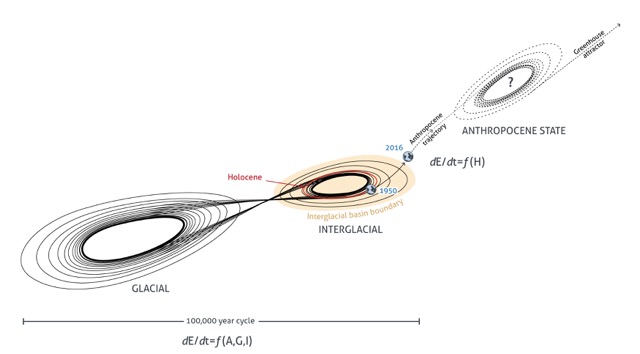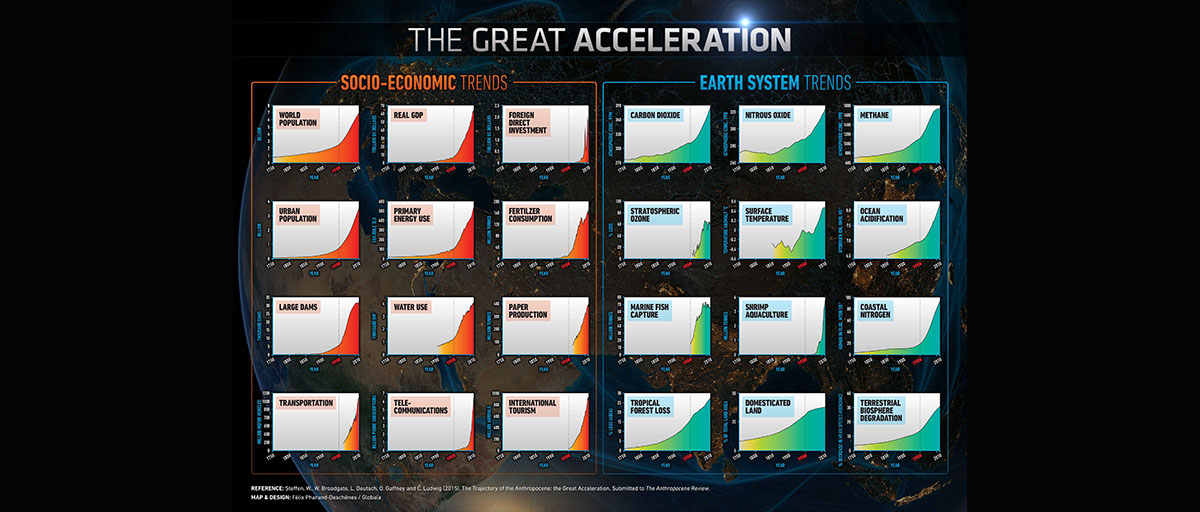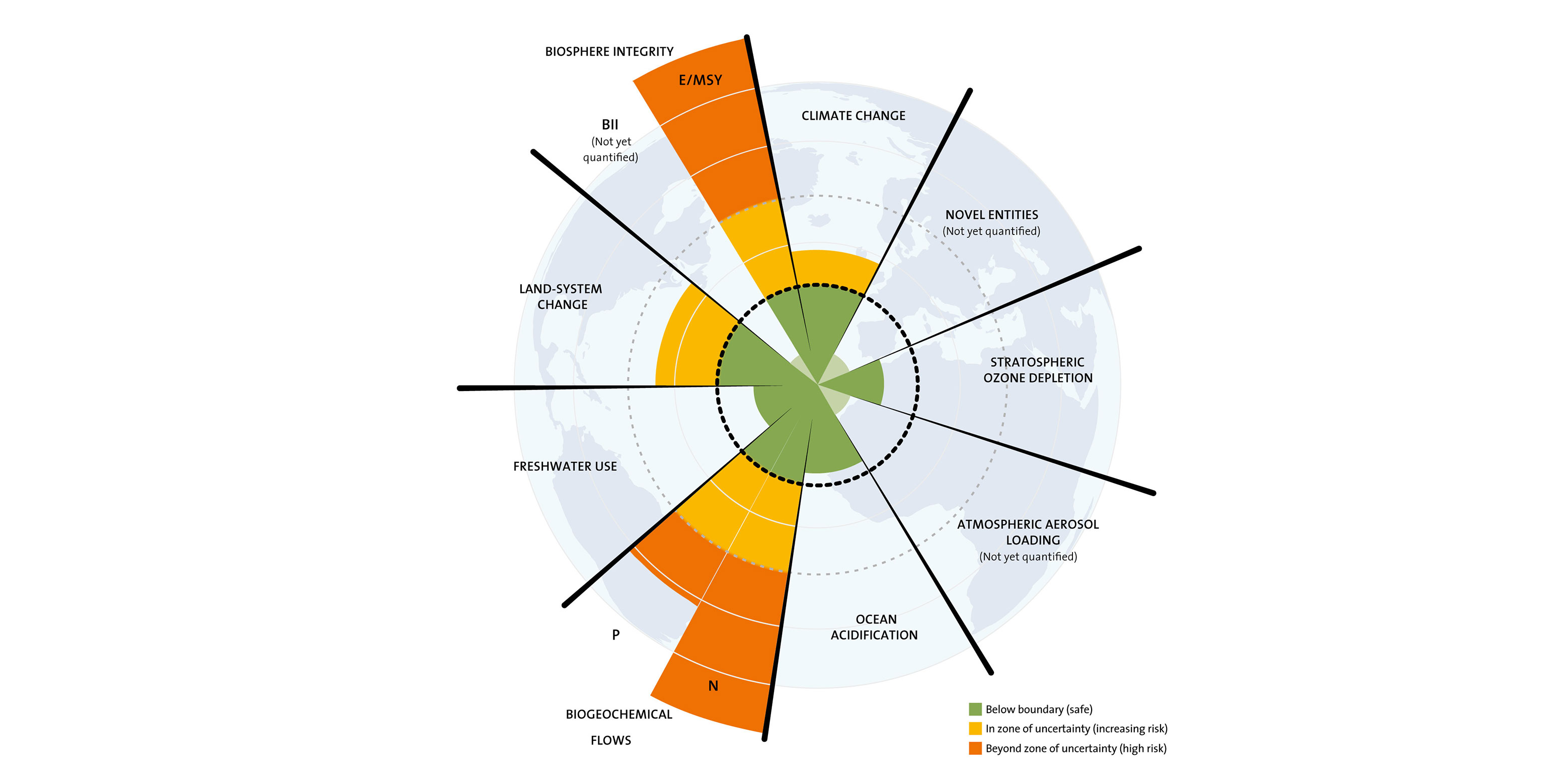
A new study published in The Anthropocene Review concludes that natural forcings approximate to zero when compared with the current change as a result of industrialised society. Photo: Ichtrinken/C.C. 3.0
Bildtext får vara max två rader text. Hela texten ska högerjusteras om den bara ska innehålla fotobyline! Photo: B. Christensen/Azote
earth system change
Formally describing the Anthropocene
New paper formalises mathematically the current rate of change of Earth’s life support system
- The paper mathematically formalises the Anthropocene in terms of the rate of change of the Earth system providing an unequivocal statement that industrialised societies have taken the reins of the Earth system.
- Astronomical and geophysical forces approach zero compared with anthropogenic influence on the rate of change of the Earth system.
- The Earth system has moved beyond the interglacial envelope
A paper recently published in the journal The Anthropocene Review puts the current rate of change of Earth’s life support system in the context of the last 4-billion-year evolution of the biosphere. The paper, which is written by the centre’s Owen Gaffney and senior research fellow Will Steffen, concludes that natural forcings approximate to zero when compared with the current change as a result of industrialised society.
“The paper came about almost as a footnote to our earlier paper, the trajectory of the Anthropocene: the Great Acceleration,” explains Gaffney.
“We were constantly trying to find new ways to nail our final conclusion into a single sentence saying industrialised societies have the force of an asteroid strike. Or, now rival or overwhelm the great forces of nature. Or humans are a prime driver of change in the Earth system.”
Gaffney and Steffen started thinking if there was a way to describe the Anthropocene more precisely and that better pinpoints the profound risks we are taking with the Earth system. The idea would be to follow Einstein’s maxim of making everything as simple as possible, but not simpler.
The origin of the author’s equation dates to 1999 when Joachim Hans Joachim Schellnhuber, director of the Potsdam Institute for Climate Impact Research, published a seminal paper on the state of the Earth system. As a starting point the authors took an equation from the paper that argued the current rate of change of the system was a function of astronomical and geological forcings, and now human forcings needed to be included.
We need to take a biosphere positive approach to economic development in the Anthropocene. We need development that stores carbon not emits it, enhances biodiversity not reduces it and purifies waters and soils not pollutes them.
Will Steffen, co-author
Intellectual developments behind the paper
Four four billion years, Earth’s biosphere has been driven by large astronomical forces caused by Earth’s orbit around the sun and gravitational interactions with other planets, the sun’s heat output and the odd massive asteroid impact. Then throw in geophysical forces – volcanic eruptions and continent collisions altering ocean currents and heat distribution. Then add internal dynamics of the system – dampening feedbacks and amplifications or evolutionary twists, like the Great Oxidation Event 2.5 billion years back when cyanobacteria evolved and spat out a poison to all other life at the time: oxygen.
Schellnhuber’s paper came a year before Paul Crutzen and Eugene Stoermer’s proposal that Earth had entered the Anthropocene, a new geological epoch. Four years later Steffen and colleagues published the first Great Acceleration graphs and Global Change and the Earth System and the Earth System: a planet under pressure. And in 2009, the centre’s Johan Rockström, Steffen and colleagues published the first planetary boundaries paper.
In light of these intellectual developments the team revisited Schellnhuber’s equation.
“We assembled data on the current rates of change of global temperature, sea level rise, greenhouse gases, biodiversity, phosphorus and nitrogen cycling, and sediment movement in rivers, then we compared this with changes in the last 7000 years as a baseline, and in deep time where possible,” Owen Gaffney explains.
From the data it became abundantly clear that astronomical and geological forcings, while still there, currently approximate to zero when compared with the sheer scale of human impact.
“So we could then summarise our findings into an admittedly abstract equation: the rate of change of the Earth system is now a function of industrialised societies, and we called this the Anthropocene equation.”
.jpeg)
The Anthropocene equation. Illustration: Gaffney/Steffen/Globaia 2017
A new lens on the state of the planet
They take temperature as an example. Over the past 7000 years, the primary forces driving change have been astronomical –subtle changes in Earth’s orbit, along with a few volcanoes. They have driven a rate of change of 0.01 degrees Celsius per century. Human forcing via greenhouse gas emissions has, over the past 45 years, increased the rate to 1.7 degrees per century. So the rate of change in climate driven by industrialised societies is 170 times faster than the rate of change driven by natural forcings. And it is in the opposite direction.
Why is this useful?
The authors point to three reasons. First, it is a new lens to view the current state of the planet. Second, it makes an unequivocal statement that industrialised societies have taken the reins of the Earth system. Third, it contributes to attribution discussions. For example, some argue it is difficult to separate out natural climatic change caused by for example El Niño from human influence. But And El Niño is followed by La Niño. They cancel each other out over a decade or so, with no net impact on the rate of change of the Earth system.
But it also shows a clear aim for societies.
“It has been argued that Earth is a very resilient system. It can take anything industrialised societies throw at it. But the current Earth system state is not as resilient as we’d previously believed,” says Gaffney.
For the last 2.5 million years – geologists call the Quaternary period – Earth has been in a particularly unstable state veering from ice age to gentle warmth every 100,000 years. Compare this to before the Quaternary when Earth would often settle into a deep freeze or greenhouse state for millions of years without budging – little would shift it.
Can the Anthropocene equation be solved?
As centre researchers have shown in the past, the last 10,000 years have been remarkably stable, so much so that it has allowed agriculture to emerge, followed by villages, cities and later still a global civilization.
“We have now disturbed this pattern. We’re tickling the tail of a dragon as physicist Richard Feynman once said of the atomic bomb.”
The big question is, can the Anthropocene equation be solved?
“Well, probably not. Human societies are too complex. What we can say is that the rate of change needs to become zero soon. It is difficult to imagine a global civilization functioning on a destabilizing Earth system,” Will Steffen says.
“We need to take a biosphere positive approach to economic development in the Anthropocene. We need development that stores carbon not emits it, enhances biodiversity not reduces it and purifies waters and soils not pollutes them.”
But, he says, societies can transform rapidly.
It seems, for example, that global fossil fuel emissions growth has peaked. It is all the more surprising that this has happened while the global economy has grown. So there is room for some optimism.

Earth system basins of attraction during the Quaternary period and now. Illustration: Gaffney O., Steffen W. 2017. The Anthropocene equation. The Anthropocene Review
Gaffney O., Steffen W., The Anthropocene equation. 2017. The Anthropocene Review (10 February 2017) https://doi.org/10.1177/2053019616688022

Owen Gaffney is director of international media and strategy at the Stockholm Resilience Centre. For a decade he has worked in Earth system science communication. His work focuses on understanding, communicating and visualizing humanity's impact on the planet through concepts such as the Anthropocene and planetary boundaries, and transformation processes.

Will Steffen is a senior research fellow at the centre. His research interests span a broad range within the field of Earth System science, with an emphasis on global sustainability integrating Earth and world dynamics, planetary boundaries and the Anthropocene








